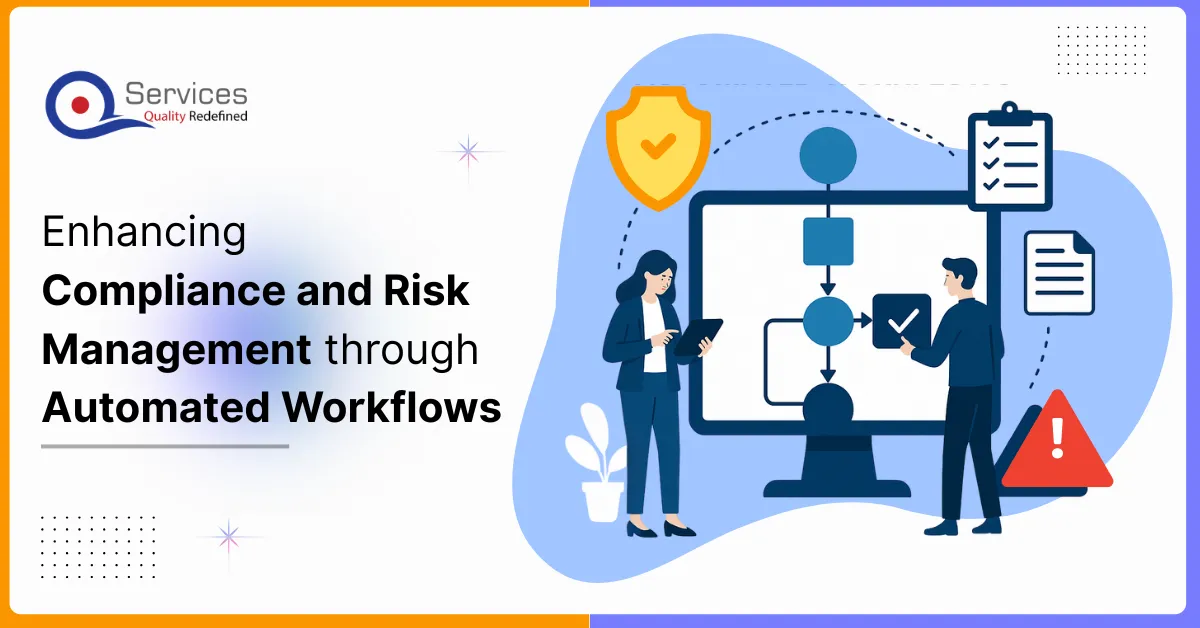
Home » Enhancing Compliance and Risk Management through Automated Workflows

The finance sector operates in an environment that demands accuracy and constant attention, especially in managing compliance and risks. Many financial institutions are relying on manual methods for these important tasks. However, such approaches are prone to errors and can be time-consuming—challenges that banks cannot afford.
Automation is proving to be a powerful solution to these issues by streamlining processes and improving accuracy. With automation tools, financial institutions can manage compliance and risk more efficiently and stay up to date with evolving regulations.
In this blog, we will deeply understand how automation is driving effortless compliance workflows and risk management in financial institutions.
Compliance and risk management are two foundational pillars of a financial organization. Compliance ensures that operations adhere to laws and regulations, while risk management helps protect against cybercrimes, market fluctuations, and other threats.
Financial institutions that implement robust compliance and risk management frameworks operate with greater confidence and fewer disruptions. While those, that neglect these areas may face costly legal penalties, financial losses that can exceed millions, and irreparable reputational damage.
Both compliance and risk management are equally important in the financial sector. They play a crucial role in preventing legal violations, safeguarding reputation, and maintaining public trust.
Automation technology makes compliance and risk management less stressful for financial institutions. It combines the power of human expertise with computer’s intelligence to automatically adhere with financial regulations and proactively manage financial risks.
Here’s a table that explains why automated solutions are more beneficial than traditional methods:
Get free Consultation and let us know your project idea to turn into an amazing digital product.

Compliance and financial risks often evolve over time, and basic automation alone doesn’t keep up. An automation solution must include the right features to handle these challenges effectively.
Here’s what a comprehensive compliance automation solution includes:
AI-Powered Risk Assessment
AI features help analyse large sets of compliance and financial data to detect risks early. This gives teams the time to review and fix potential issues before they turn serious.
Workflow Automation and Standardization
Tasks like document reviews, approvals, and policy checks can be set up as automated workflows. This ensures every step is followed the same way, reducing mistakes and speeding up compliance tasks.
Real-Time Compliance Monitoring and Alerts
The system should monitor all compliance activities as they happen and send alerts when something unusual is found. This helps teams respond quickly and avoid bigger problems later.
Integration-Friendly System
An effective solution connects easily with systems already in use—like accounting software, ERP tools, and document platforms. This allows data to stay consistent and makes compliance reporting simpler.
Audit-Ready Documentation and Traceability
Automated systems keep detailed, secure records of all compliance actions. This comprehensive traceability facilitates faster, more transparent audits and builds regulator trust.
Advanced Data Analytics and Reporting
The platform should include built-in dashboards and reports that show what’s working and what’s not. These tools help teams track performance and make better decisions to stay compliant.
While compliance automation offers significant benefits, it also introduces certain challenges that financial institutions must address:
Best Practices for Automating Compliance Processes in Finance
For maximizing the impact of automation in compliance and risk management, following the right approach is necessary. Here’s what organizations can do:
Automate High-Risk, Manual Tasks
Start by identifying areas with the highest risk of human error—such as compliance reporting, audit trails, regulatory documentation, or approval workflows. Automating these tasks improves both accuracy and speed.
Use a Platform Built for Your Needs
Look for customized automation platform not a standardized one. An automation solution that specifically matches your regulatory requirements ensure better alignment and less errors.
Choose Integration-Friendly Tool
Always ensure your automation platform integrates well with your core banking systems, accounting software, or other important areas. Seamless data flow prevents duplication and ensures timely regulatory reporting.
Review, Test, and Improve Regularly
Compliance regulations often change, whether it’s FATF guidelines, central bank directives, or evolving data privacy laws. Schedule timely audits of your automation tools.
Hire Automation Specialists
If automation feels too complex, bring in experts like QServices. They can build the right setup, connect seamlessly with your systems, and give ongoing help —so your institution stays compliant and competitive without added internal strain.
Share your project idea with us. Together, we’ll transform your vision into an exceptional digital product!

Compliance and risk management go hand in hand for banks and managing them proactively is essential. As manual approaches continue to fall short in today’s environment, automated compliance workflows are delivering exactly what regulatory bodies expect.
With automation, financial institutions can monitor compliance in real time, enable AI-powered risk assessments, and maintain audit-ready records with ease.
Compliance and risk management become far more efficient when banks adopt the right automation solutions. With QServices as your financial process automation partner, organizations can manage risk more effectively and stay fully compliant.
A compliance risk management plan outlines policies, controls, and procedures that help organizations identify, assess, and mitigate regulatory and operational compliance risks
Systems monitor compliance tasks in real time and send notifications for missed deadlines, anomalies, or required approvals.
Real-time monitoring, early risk detection, reduced human errors, faster response times, and proactive threat mitigation through AI-powered analytics.
Advanced AI, predictive analytics, blockchain integration, natural language processing, and increased focus on ESG compliance and sustainability.
Yes, modern platforms integrate regulatory feeds to automatically update rules and requirements, ensuring continuous compliance with evolving regulations.
Credit risk, operational risk, market risk, liquidity risk, cyber risk, and regulatory compliance risks through comprehensive monitoring systems.
Yes, cloud-based solutions offer scalable pricing models, making automation accessible for smaller institutions with limited IT budgets.
Machine learning algorithms continuously improve accuracy by learning from user feedback, reducing false alerts while maintaining detection sensitivity.
Basic system navigation, understanding automated workflows, interpreting alerts, and escalation procedures typically require 2-4 weeks of training.
Platforms that are built by reputable firms like QServices follow strict data protection standards, use encryption, and offer role-based access to safeguard sensitive compliance data.

Have a one on one discussion with our Expert Panel

As digital expectations grow, customers now demand speed, ease of use, and 24/7 availability. To meet these demands at scale, digital-only banks choose business process automation in the banking industry to deliver consistent, responsive, and personalized service.

Processing payments involves multiple steps, such as verifying account details, checking records, and ensuring timely execution. In the current financial environment, manual approaches slow down these processes and increase the risk of errors.

Robotic Process Automation (RPA) is no longer limited to large, national banks. Smaller financial institutions like community banks, credit unions, and regional institutions have started implementing this modern automation to find real, practical value.
INDIA : F-190, Phase 8B, Industrial Area, Sector 74,
Mohali, India
CANADA : 55 Village Center Place, Suite 307 Bldg 4287, Mississauga ON L4Z 1V9, Canada
USA :2598 E Sunrise Blvd, Fort Lauderdale,FL 33304,
United States

Founder and CEO

Chief Sales Officer
